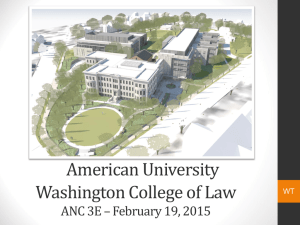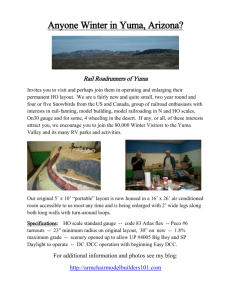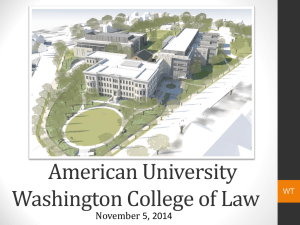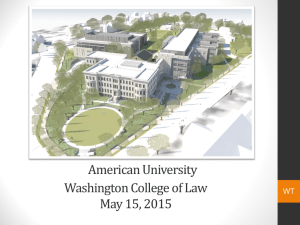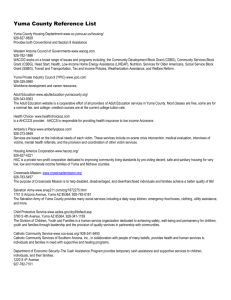A P P L I C AT I O N ... A U G U T S T 2 2... WA S H I N G T I O N ...
advertisement
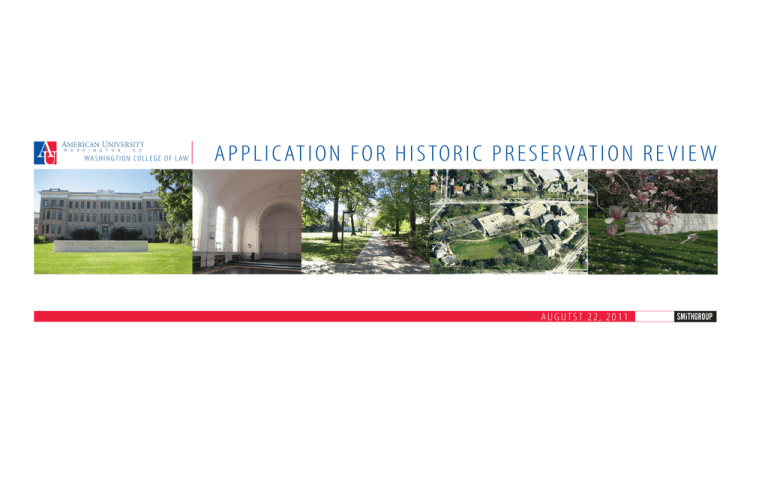
WA S H I N G T I O N CO L L E G E O F L AW A P P L I C AT I O N F O R H I S TO R I C P R E S E R VAT I O N R E V I E W AU G U TS T 2 2 , 2 0 1 1 TABLE OF CONTENTS Application for Historic Preservation Review Additional Information for Larger and Commercial Projects Site Diagrams and Plans 1.0 Existing Urban Context Diagram 2.0 Proposed Site Plan 3.0 Preliminary Landscape Plan 4.0 Tree Preservation Plan 5.0 Pedestrian and Vehicular Circulation Diagram Building Elevations and Sections 6.0 Key Plan 7.0 Longitudinal Site Sections 8.0 Transverse Site Sections 9.0 Building Elevations 10.0 Building Elevations 11.0 Building Elevations Renderings and Photo Montages 12.0 Aerial View 13.0 View From Tenley Circle 14.0 Yuma Entry View 15.0 Yuma Façade View 16.0 Nebraska – Warren Street View 17.0 Nebraska Entry View 18.0 Courtyard View – Dunblane Approach 19.0 Courtyard View – Dunblane From Chapel Building Plans 20.0 Lower Level Floor Plan 21.0 First Floor Plan 22.0 Second Floor Plan 23.0 Third Floor Plan 24.0 Fourth Floor Plan 25.0 First Parking Level Floor Plan 26.0 Second Parking Level Floor Plan 7. ADDITIONAL INFORMATION FOR LARGER AND COMMERCIAL PROJECTS General Nature of the Project The project consists of the relocation of the Washington College of Law (WCL) to the Tenley Campus, which is currently used for American University’s Washington Semester Program. WCL will occupy approximately 300,000-310,000 total gross square feet of space, approximately 65,000 of which will be located in Capital Hall and 235,000-245,000 in new construction consisting of new additions to Capital Hall located on Nebraska Avenue and Yuma Street. The project will include renovations to Dunblane House, repurposing the 1920s chapel located to the west of Capital Hall, and retention of a 1950s hyphen structure. Associated site development includes retention of the central campus green space, development of entry courts on Nebraska Avenue and Yuma Street, modifications to the lawn in front of Capital Hall to create a publicly accessible outdoor space, and general landscape development along the site’s perimeter. Program The program of uses includes instructional facilities, ranging from 25-person capacity seminar rooms to 100-person tiered classrooms and a 140-capacity ceremonial courtroom; the Law Library, with collections storage, study and research areas, and librarian offices; administrative offices; faculty offices; law clinics with student work space, client interview rooms, specialized instructional facilities and faculty offices; student spaces including student organizations, law journals and briefs, lounges and group study rooms, a dining room and lockers; and offices and meeting space for WCL centers and programs, which provide research, scholarship and support for specialized legal initiatives. Approximate Gross Floor Area by Use Instructional Facilities: 74,400 GSF Law Library: 67,500 GSF Administrative Offices: 35,500 GSF Faculty Offices: 37,500 GSF Law Clinics: 11,100 GSF Student Spaces: 62,000 GSF Centers and Programs: 22,000 GSF Preservation Work The scope of preservation work encompasses interior renovations to 1903 Capital Hall and to its 1920’s L-shaped addition and chapel; renovations to the circa 1839 Dunblane House; retention of the interior campus green space and additional site treatments; retention and reconstruction of a 1955 hyphen structure at Nebraska Avenue; and design and articulation of the new Law School structures in a manner compatible with the historic structures. Capital Hall Capital Hall is a 4 story structure constructed in approximately 1903 in the Baroque Revival style with primary street frontage along Wisconsin Avenue at Tenley Circle. A chapel and L-shaped addition were added to the original structure between 1919 and 1921. The L-shaped addition is also 4 stories and extends the floor levels of the existing structure and provides additional street frontage to the south along Nebraska Avenue. The chapel is located west of the original structure and does not have a prominent street façade. The primary street façades of Capital Hall consist of monolithic masonry walls fenestrated with vertical punched windows and finished with limestone masonry veneer. Architectural embellishments include facetted bay windows, articulated cornices, projecting sills, belt courses, dentals and keystones. Non-street facades, including the chapel, consist of utilitarian monolithic masonry walls with very little architectural embellishment. Capital Hall was adaptively renovated into student housing after AU acquired the property in 1986. Subsequent projects have included the installation of a new roof, new aluminum- framed insulated windows and masonry repair and repointing. The proposed renovation of Capital Hall will be primarily focused on interior spaces, adapting most of the existing structure for office and small meeting use. No changes are proposed for the primary exterior façades of Capital Hall. Any work to the exterior at these locations will be focused on the restoration and maintenance of the historic structure. Capital Hall’s existing exterior service court will be enclosed and converted into an enclosed atrium to facilitate connections to the new Yuma Street addition at the second, third, and fourth levels. This new atrium space will be activated by a small café venue and will function as central orientation point and common area for the east end of the facility. The service court façades to the west, which will become enclosed at the original 1903 section and remain exterior at the L-shaped 1920’s addition, are of buff-colored brick and utilitarian in appearance. New openings at the enclosed center stair section will be created in order to connect the complex of structures and the brick surfaces may be enhanced by application of lime slurry, stucco, or paint (see description of chapel below). Chapel The chapel was built in 1921 and contains 3 floors: the main sanctuary now used as a dance instruction space, a lower level, and a choir loft. The east end is connected to Capital Hall by a very utilitarian walkway which will be removed. The main sanctuary will become a moot courtroom, the lower level will be reconfigured to house three advocacy training spaces and the choir loft will be used for storage/support because of the difficulty of providing appropriate egress for its use as an occupied space. To the east, the chapel will be connected to Capital Hall and the new building by the glass-roofed atrium space described above. A new stair, elevator, and walkways at the upper levels will facilitate physical connections between Capital Hall, the chapel, and the new Law School additions. The floor levels in each of these structures do not align and the atrium will serve as a means of connection. At the first floor, an open passage to permit site access will be created (see further description below). The main sanctuary space contains a decorative plaster ceiling and double-height, arched, stained glass windows which will remain; courtroom furniture including a judge’s bench and spectator seating will be installed. Minor modifications will be made to the chapel exterior which in its current condition is fairly utilitarian in appearance. The utilitarian appearance is attributable to its position behind Capital Hall visually shielded from primary surrounding streets and public space. In addition, the built structure deviates significantly from the original design described by the original construction documents. The exterior especially was considerably simplified most likely to reduce the cost of its construction. Modifications will include enlarging the existing stair found in the southeast corner of the narthex and creating modestlyscaled new openings in the east facade to provide appropriately-scaled public access to the moot courtroom within the main sanctuary. At the west façade, a new central opening and stair well be created to provide access to a new exterior terrace and to create a greater visual presence for the chapel when viewed from the central green space. In the new site configuration the chapel will assume a much more visually prominent role, as a focus of the Yuma entry sequence and as a focus of the active central green space. A concept for the exterior treatment of the chapel will be developed for consideration as the design develops which may include lime slurry, stucco or paint in order to subtly enhance the existing utilitarian appearance. Dunblane House Dunblane is a circa 1839 Greek Revival style house. A two-story wing was added in 1935 and a one-story addition in the mid 1970’s. A significant fire resulted in the loss of almost all of the original fabric in 1995. While AU does not propose to remove any portion of the 1974 addition to Dunblane House at this time, it does reserve the right to do so in the future. AU anticipates that WCL uses of Dunblane will include: administrative offices, the department of Alumni Affairs, and offices for visiting faculty and scholars. The interior, which currently contains faculty administrative office space, may require minor reconfiguration to accommodate these new uses. Minor repairs are anticipated to the exterior façade, but the exterior appearance will remain generally unaltered from its current condition. Site The proposed development will preserve the character of the existing central green space and will maintain existing pedestrian site circulation and access from Yuma Street and Nebraska Avenue. The central green space contains the remnants of the axial drive from Dunblane to Wisconsin Avenue as indicated in an early (1857-58) topographic map. The proposed design will retain the axial drive and the existing allee of trees as well as much of the overall site’s existing mature landscaping. The central green space will be activated by a new structured terrace that links the Nebraska and Yuma additions, envisioned as a focal point and gathering space. The terrace surface will be paved and planted and furnished for daily activity. The terrace will include a series of skylights to both naturally illuminate the occupied space below and provide sculptural lit elements within the internal green space. The existing grades near the corner of Yuma and 42nd Streets suggest the presence of a former carriage drive which is also indicated on the 1955 construction documents. A new path will be created at this location to provide access to the site interior. Direct access to the central space will be possible from both Nebraska and Yuma: at Nebraska, the existing 1950’s hyphen will be retained (see below) and the Yuma building entrance will include an open portal that creates a more public and welcoming condition than does the current service court at this location. The existing lawn in front of Capital Hall will be redefined to better engage pedestrian activity and public access from Tenley Circle. This aspect of the proposed design is a direct result of a constructive dialogue process with the neighborhood community (see further description below). The new design also strengthens the identity of Capital Hall as part of WCL along the prominent Wisconsin Avenue corridor. The lawn is shaped as an elevated ellipse accessed by a new stair that contains planters and broad steps to serve as seating. The new system of paths and plantings that form the ellipse will direct circulation around Capital Hall and focus visual access to two new primary entry courts that frame the foreground for the new building additions. The Yuma Street sidewalk will be enlarged and the existing Perna stone walls will be rebuilt in order to accommodate the new configurations. The Yuma Street entry court will facilitate convenient access from the Tenleytown Metro Station and provide entry directly into the central green space, Capital Hall and the new academic and office wing. The Nebraska Avenue entry court will provide entry into the new academic and law library wing while also providing access to the central green space through the existing hyphen structure. Originally constructed in 1955, the hyphen is a low covered walkway that currently links Capital Hall and Congressional Hall. This open-air architectural element is constructed of concrete, limestone and fieldstone and will be preserved and adapted to link Capital Hall to the new building addition while providing an open gateway into the site. As much of the existing hyphen will remain in place as is possible: the portion to the east that directly connects to Congressional Hall will be rebuilt following Congressional Hall’s demolition. Repairs will be performed along with modifications to adapt to new topography and grade requirements. New Building Additions The new building additions proposed at Nebraska Avenue and Yuma Street are designed to be both compatible with Capital Hall and reflective of the mission, values and purpose of WCL. The proposed 4-story Nebraska Avenue wing will contain a formal entry space, a ceremonial courtroom, instructional facilities, and the Law Library. The building’s roof is at elevation 449’ with a penthouse level at 467’. The roof of Capital Hall is at elevation 449.7’. The penthouse level is located 100 feet away from Capital Hall. The façades will be composed primarily of brick masonry with large expanses of glass and aluminum curtainwall and limestone veneer. The architectural expression is clearly modern, and the scale and proportion of openings and vertical articulation is harmonious with Capital Hall. The large limestone solid portion of the Nebraska façade and corresponding glass and limestone portion of the Warren Street façade represent the ceremonial courtroom while the transparent, glassy area of the Nebraska façade contains a large double-height reading room. The composition creates an iconographic image of law school activity. The design approach for the Yuma Street wing contrasts to Nebraska: the composition is carefully calibrated to be compatible with both Capital Hall and with the surrounding context of the Convent of Bon Secours and four residences to the west along Yuma, and is much-reduced in scale and articulation. Because of the grade change which falls significantly from north to south across the site, 4 stories at Yuma are visible above grade while the first level, aligned with the Nebraska wing’s first level, is positioned below grade. The level below grade and the first floor will contain instructional and student spaces; the second and third floors will house faculty offices and the law clinics; and the top floor will contain instructional spaces. The roofline varies in height, creating the appearance of separate structures and articulating the length of the façade. The main portion of roof is at elevation 449’ (Capital Hall is at 449.7’). The recessed top floor is at elevation 465’, located 80 feet away from Capital Hall. Three small pavilion elements are at elevation 456’, with the nearest being 200 feet away from Capital Hall. The Yuma wing is connected to Capital Hall by a glassy, bridge-like façade, maintaining the appearance of separate structures. A portion of the first floor is left open and unenclosed, revealing the chapel and providing direct access to the interior of the site. The exterior façades will be composed primarily of brick masonry with areas of glass and aluminum curtainwall and limestone veneer. The massing consists of a series of pavilion-like elements with deep, 30-foot wide gaps between them, creating the appearance of a series of structures very much in scale with the surrounding context. The internal courtyard façades are varied in height and scale and contain large expanses of glass, meant to connect internal and external activity. Additional Features Community Dialogue Process AU engaged in a facilitated dialogue process with representatives of ANC 3E and the Tenley Campus Neighborhood Association (TCNA) from late 2010 – spring 2011. The goal of this process was to allow each of the party’s to articulate their goals and concerns for the development of the Tenley Campus and the relocation of the Washington College of Law to the Tenley Campus. This process included representatives of WCL and AU’s architectural team, as well as an architect selected by TCNA. In addition to these facilitated meetings, AU and its architects engaged in a series of design meetings with representatives of OP, HPO, ANC 3E, TCNA, the Tenleytown Historical Society and community representatives. In these meetings many issues were reviewed and discussed including: site development priorities, building massing, height and density, vehicular and pedestrian access, landscape character, parking facilities, historic preservation, building program and neighborhood amenities. While agreement was not reached among the meeting participants as to all aspects of the proposed design, certain design principles were reviewed and some consensus was achieved. These design principles included: · · · · · · · Creation of a highly effective and functional facility for WCL that builds upon the college’s rich heritage and enhances its academic resources and diverse programs; Concentration of development density on the eastern portion of the Tenley Campus in order to minimize the visual impact on the surrounding neighborhoods; Development of a meaningful campus aesthetic that maintains accessibility to open areas and green space to the Tenley Campus and creates an appropriate relationship to the adjacent community, including the Wisconsin Avenue commercial corridor; Maintenance of the organizational principles that informed the existing condition and influenced the nature of the central green space and sense of academic campus that has evolved over time; Maintenance and enhancement of the landscape transitional zone along Warren, 42nd, and Yuma Streets; Preservation and strengthening of the historic character of the Tenley Campus (including Capital Hall and Dunblane); and Leveraging the Tenley Campus’ proximity to the Tenleytown Metro Station. Sustainable Design Improvements to the Tenley Campus will prioritize and actively promote environmentally sustainable development principles. Carbon emissions and fossil fuel consumption will be minimized by facilitating access to the site via multiple modes of public transportation, including city and campus buses and Metrorail. Site amenities will include bicycle racks and shower facilities to encourage bicycle commuting. Innovative management of solar heat gain, stormwater quantity and quality, potable water use and HVAC refrigerants will be implemented to minimize negative environmental effects. Building systems and site infrastructure will be designed for optimum performance to minimize energy consumption. Construction materials will be specified that require minimal embodied energy and maximize recycled content or are rapidly renewable. Interior spaces will promote healthy environments by minimizing airborne contaminants and maximizing personal comfort by providing effective and adaptable HVAC systems and by emphasizing access to natural light and views. The objective of attaining LEED Gold Certification has been established for the project. Fort Dr. NW W 39th St. NW St. N nd 42 co Wis W Av e. N . NW Ave sk a nsin Warren St. NW Ne bra 43rd St. NW Yuma St. NW Van Ness St. NW EXISTING URBAN CONTEXT DIAGRAM August 22, 2011 1’’=300’ 1.0 ON S WISC 67.96’ E NW IN AV YUMA ST NW EL 406’ Measuring Point 29.75’ D ST 29.34’ 449’ T.O.S. 456’ T.O.S. NW 78.52’ 14.01’ 11.27’ 44.90’ 449.7’ T.O.S. AA VE N W 42N 465’ T.O.S. NEB R ASK 449’ T.O.S. 439.5’ T.O.S. 69.55’ Property Line 436.5’ T.O.S. 467’ T.O.S. EL 386’ Measuring Point 449’ T.O.S. 12.74’ 39.92’ WARREN ST NW PROPOSED SITE PLAN August 22, 2011 1’’=100’ 2.0 PRELIMINARY LANDSCAPE PLAN August 22, 2011 1’’=100’ 3.0 NEB R ASK AA VE N W E NW IN AV 42N D ST ONS WISC NW YUMA ST NW Legend: Trees to be removed Proposed trees Existing trees to remain WARREN ST NW TREE PRESERVATION PLAN August 22, 2011 1’’=100’ 4.0 Legend Primary Pedestrian Circulation Secondary Pedestrian Circulation Vehicular Circulation Vehicular Access Loading D ST ONS WISC NW YUMA ST NW W ASK NEB R NEB R ASK AA VE N W AA VE N E NW IN AV 42N D ST ONS WISC NW E NW IN AV 42N YUMA ST NW WARREN ST NW WARREN ST NW PEDESTRIAN AND VEHICULAR CIRCULATION DIAGRAM August 22, 2011 1’’=100’ 5.0 YUMA ST NW N ATIO V E L TH E NOR NW D ST EVA W AA VE N ION SECT SECT SITE SITE ERSE ERSE ASK NSV NSV NEB R 42N E NW IN AV TION TRA TRA TION RD TYA R COU NEC CON T ST A T ST A - EA - EA ION TH NOR N IO SECT E T I S TH SOU INAL D U N T O GI TI LON E SEC T I S L DINA U T I G LON ONS WISC T EL EAS RD RTYA U O -C ION T A V LE D TH E TYAR R U SOU CO ON I T A LEV TH E R O N WARREN ST NW KEY PLAN TION EVA E/ L E V TH SOU RASKA A NEB REN ST WAR August 22, 2011 1’’=100’ 6.0 August 22, 2011 1’’=90’ 7.0 August 22, 2011 1’’=90’ 8.0 August 22, 2011 1’’=40’ 9.0 August 22, 2011 1’’=40’ 10.0 August 22, 2011 1’’=40’ 11.0 AERIAL VIEW August 22, 2011 N.T.S. 12.0 VIEW FROM TENLEY CIRCLE August 22, 2011 N.T.S. 13.0 YUMA ENTRY VIEW August 22, 2011 N.T.S. 14.0 YUMA FACADE VIEW August 22, 2011 N.T.S. 15.0 NEBRASKA - WARREN VIEW August 22, 2011 N.T.S. 16.0 NEBRASKA ENTRY VIEW August 22, 2011 N.T.S. 17.0 COURTYARD VIEWDUNBLANE APPROACH August 22, 2011 N.T.S. 18.0 COURTYARD VIEWDUNBLANE FROM CHAPEL August 22, 2011 N.T.S. 19.0 1’’=50’ 20.0 1’’=50’ 21.0 1’’=50’ 22.0 1’’=50’ 23.0 1’’=50’ 24.0 1’’=50’ 25.0 1’’=50’ 26.0
